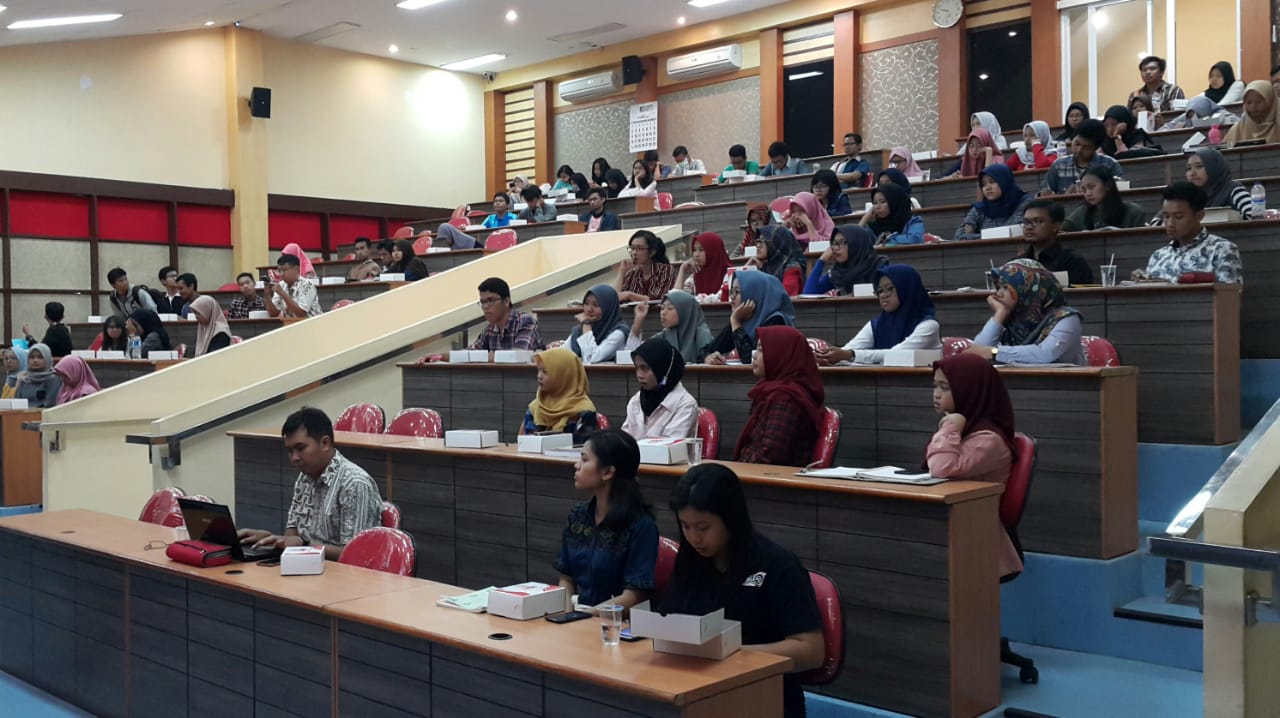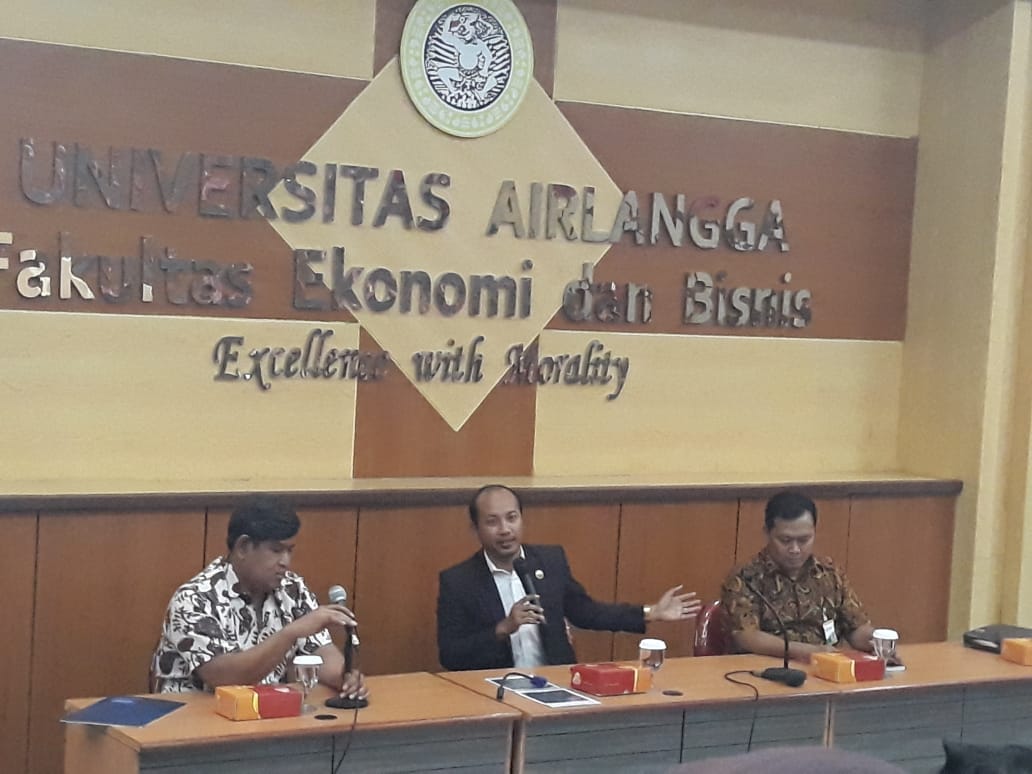On Friday, 12 October 2018, the Faculty of Economics and Business (FEB), Universitas Airlangga (Unair), held a general discussion entitled "Overview of Production Structure and Upstream Industry in the Agricultural Sector" in the Tower Hall, FEB Unair, Jl. Airlangga No.4-6, Surabaya. The discussion also discussed two books from the speaker, namely Dr. Gutomo Priatmono, PSPK-UGM Researcher and author of the book "Tumbal: Failed Agricultural Development in the Republic of Indonesia in the 1960-2000s", and Muhammad Ihwan, SP, M.Si, Public Relations Manager of Petrokimia Gresik and team of authors of the book "Real Steps to Become a Solution for Agroindustry: Petrokimia Gresik's 46 year progress in developing the agricultural sector."
 Akhmad Jayadi, SE, M.Ec.Dev., lecturer at FEB Unair as the moderator opened the discussion with facts about the urgency of the agricultural sector for the Indonesian economy. According to him, the role of agriculture can be described in at least three ways: third contributor (14%) to national GDP; absorbing 44% of the workforce; and producer of staple food for the population. According to Jayadi, the agricultural sector in Indonesia faces many challenges, starting from a decline in production, a reduction in planting land, and an increase in consumption due to the high population.
Akhmad Jayadi, SE, M.Ec.Dev., lecturer at FEB Unair as the moderator opened the discussion with facts about the urgency of the agricultural sector for the Indonesian economy. According to him, the role of agriculture can be described in at least three ways: third contributor (14%) to national GDP; absorbing 44% of the workforce; and producer of staple food for the population. According to Jayadi, the agricultural sector in Indonesia faces many challenges, starting from a decline in production, a reduction in planting land, and an increase in consumption due to the high population.
Problems in the agricultural sector can be described from four levels in the agricultural system, namely: the upstream industrial subsector, namely the provider of agricultural production facilities; then the farming subsector (on farm), namely economic activities to produce food products, horticulture, etc.; then the downstream industry subsector, namely processing, packaging and trading; and finally from supporting subsectors such as finance, transportation, R&D, warehousing etc.
Dr Gutomo explained that agricultural productivity had stagnated. Farmers only have a surplus of IDR 450-600 thousand per harvest (+- 3 months), while farmers' expenses reach IDR 1.5-1.7 million per month for necessities, including buying rice. The question is, why do farmers still buy rice? It turns out that after the green revolution, farmers' grain did not last long so farmers did not store grain, so farmers suffered losses of 4000-6000 rupiah per kg, depending on the quality of the rice purchased. As a result, the surplus is still imaginary. The only one who enjoys a surplus is Bulog which functions to secure national politics through top and bottom price policies.
Another finding is the dualism of production models and ideology, where since 1965 the program to increase productivity towards food self-sufficiency has been implemented in two ways, namely: 1) agricultural modernization through the green revolution (superstructure), with agricultural development as the structure; 2) agricultural institutions such as farmer groups, KUD and irrigation as infrastructure which also aims for productivity. Enlarging farming businesses in the first method is the capitalist mode of production, while the second method is in the form of cooperatives representing the socialistic mode of production.
The second presenter, Muhammad Ihwan discussed all things about fertilizer, especially the production of PT Petrokimia Gresik. Ihwan proposes a holistic view of the agricultural system, namely that there is no separation between upstream and downstream subsectors. Petrochemicals provide almost all upstream inputs such as fertilizer, seeds, soil amendments, pest control and decomposers. The contribution of petrochemicals in the agricultural sector is support for every agricultural cycle: providing fertilizer, increasing productivity, demonstration plots/education/socialization, agricultural innovation activities, and farmer regeneration.
One of the problems with subsidized fertilizer is scarcity. According to Ihwan, this is not due to a lack of Petrochemical production capacity, but rather because the government's allocation (9.55 million tonnes) was given less than the regional proposal (13.18 million tonnes). Among all types of subsidized fertilizer, Urea has the largest allocation, namely 4.1 million tons (43%). Among the 5 types of subsidized fertilizer, only ZA, SP-36 and NPK Phonska are distributed throughout Indonesia. Meanwhile, Urea is only in 10 districts in East Java, and Petroganik is only in 8 provinces. Ihwan provided data that the uptake of phonska and petroganic fertilizers was proven to be in line (and increasing) with increases in rice and corn productivity.
 This discussion received an enthusiastic response from the participants as evidenced by the emergence of 10 questions from various points of view. For example, Mrs. Atina, Mrs. Muryani, Mrs. Fitriyah and Mr. Wahyu as lecturers at Universitas Airlangga . Then Mr Yoyok, Mr Danang, and Mr Yudi from the Association of agricultural graduates or professions. Mrs. Silvana and Mr. Jakfar represented doctoral students, and Rizal represented undergraduate students. The audience's questions targeted agricultural policies from the Sukarno, Suharto to Jokowi era. Another question is about the role of petrochemicals in producing young farmers who are increasingly rare in Indonesia through national Jamboree activities.
This discussion received an enthusiastic response from the participants as evidenced by the emergence of 10 questions from various points of view. For example, Mrs. Atina, Mrs. Muryani, Mrs. Fitriyah and Mr. Wahyu as lecturers at Universitas Airlangga . Then Mr Yoyok, Mr Danang, and Mr Yudi from the Association of agricultural graduates or professions. Mrs. Silvana and Mr. Jakfar represented doctoral students, and Rizal represented undergraduate students. The audience's questions targeted agricultural policies from the Sukarno, Suharto to Jokowi era. Another question is about the role of petrochemicals in producing young farmers who are increasingly rare in Indonesia through national Jamboree activities.
This event was considered a success by the participants. For example, Mr. Abdus Salim hopes that further discussions will continue to be held at FEB Unair, for example regarding downstream industries in the agricultural sector, as well as the role of supporting industries, such as financial institutions, IT, R&D and campuses in supporting the agricultural sector, for example through financial technology and application platforms. (AJ-AS)


























